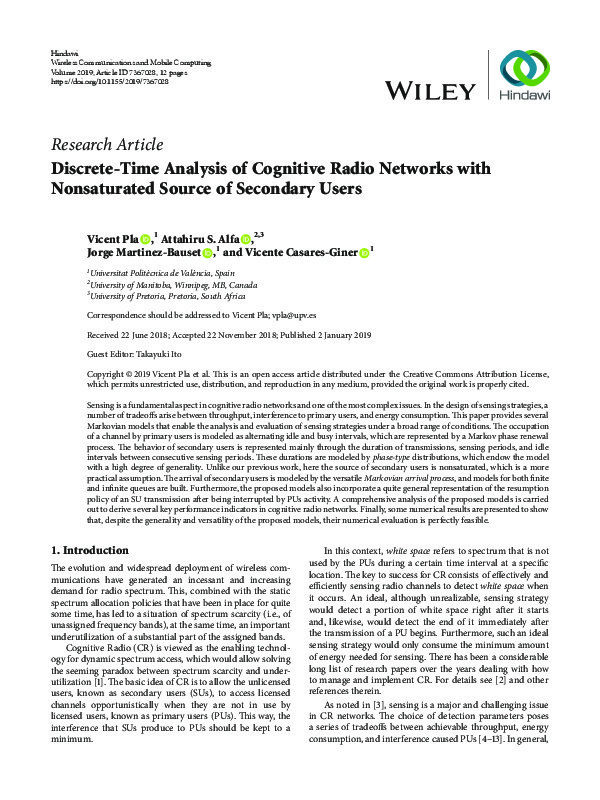Zhang, J., Zheng, F.-C., Gao, X.-Q., & Zhu, H.-B. (2015). Which Is Better for Opportunistic Spectrum Access: The Duration-Fixed or Duration-Variable MAC Frame? IEEE Transactions on Vehicular Technology, 64(1), 198-208. doi:10.1109/tvt.2014.2318512
Pradhan, H., Kalamkar, S. S., & Banerjee, A. (2015). Sensing-Throughput Tradeoff in Cognitive Radio With Random Arrivals and Departures of Multiple Primary Users. IEEE Communications Letters, 19(3), 415-418. doi:10.1109/lcomm.2015.2393305
Huang, L.-F., Zhou, S.-L., Guo, D., & Chao, H.-C. (2013). MHC-MAC: Cognitive MAC with asynchronous-assembly line mode for improving spectrum utilization and network capacity. Mathematical and Computer Modelling, 57(11-12), 2742-2749. doi:10.1016/j.mcm.2011.11.074
[+]
Zhang, J., Zheng, F.-C., Gao, X.-Q., & Zhu, H.-B. (2015). Which Is Better for Opportunistic Spectrum Access: The Duration-Fixed or Duration-Variable MAC Frame? IEEE Transactions on Vehicular Technology, 64(1), 198-208. doi:10.1109/tvt.2014.2318512
Pradhan, H., Kalamkar, S. S., & Banerjee, A. (2015). Sensing-Throughput Tradeoff in Cognitive Radio With Random Arrivals and Departures of Multiple Primary Users. IEEE Communications Letters, 19(3), 415-418. doi:10.1109/lcomm.2015.2393305
Huang, L.-F., Zhou, S.-L., Guo, D., & Chao, H.-C. (2013). MHC-MAC: Cognitive MAC with asynchronous-assembly line mode for improving spectrum utilization and network capacity. Mathematical and Computer Modelling, 57(11-12), 2742-2749. doi:10.1016/j.mcm.2011.11.074
Wang, S., Wang, Y., Coon, J. P., & Doufexi, A. (2012). Energy-Efficient Spectrum Sensing and Access for Cognitive Radio Networks. IEEE Transactions on Vehicular Technology, 61(2), 906-912. doi:10.1109/tvt.2011.2180549
Tang, L., Chen, Y., Hines, E. L., & Alouini, M.-S. (2011). Effect of Primary User Traffic on Sensing-Throughput Tradeoff for Cognitive Radios. IEEE Transactions on Wireless Communications, 10(4), 1063-1068. doi:10.1109/twc.2011.020111.101870
Yuan Wu, & Tsang, D. H. K. (2011). Energy-Efficient Spectrum Sensing and Transmission for Cognitive Radio System. IEEE Communications Letters, 15(5), 545-547. doi:10.1109/lcomm.2011.032811.110102
Wu, Y., Lau, V. K. N., Tsang, D. H. K., & Qian, L. P. (2012). Energy-Efficient Delay-Constrained Transmission and Sensing for Cognitive Radio Systems. IEEE Transactions on Vehicular Technology, 61(7), 3100-3113. doi:10.1109/tvt.2012.2198506
Hoang, A. T., Liang, Y.-C., Wong, D. T. C., Zeng, Y., & Zhang, R. (2009). Opportunistic spectrum access for energy-constrained cognitive radios. IEEE Transactions on Wireless Communications, 8(3), 1206-1211. doi:10.1109/twc.2009.080763
Chang, N. B., & Mingyan Liu. (2009). Optimal Channel Probing and Transmission Scheduling for Opportunistic Spectrum Access. IEEE/ACM Transactions on Networking, 17(6), 1805-1818. doi:10.1109/tnet.2009.2014460
Wellens, M., Riihijärvi, J., & Mähönen, P. (2009). Empirical time and frequency domain models of spectrum use. Physical Communication, 2(1-2), 10-32. doi:10.1016/j.phycom.2009.03.001
Alfa, A. S. (2016). Applied Discrete-Time Queues. doi:10.1007/978-1-4939-3420-1
Bae, Y. H., Alfa, A. S., & Choi, B. D. (2011). Analysis of a contention-based opportunistic spectrum access under general channel activity model. Performance Evaluation, 68(3), 271-289. doi:10.1016/j.peva.2010.12.003
Robert, S., & Le Boudec, J.-Y. (1997). New models for pseudo self-similar traffic. Performance Evaluation, 30(1-2), 57-68. doi:10.1016/s0166-5316(96)00055-7
[-]









